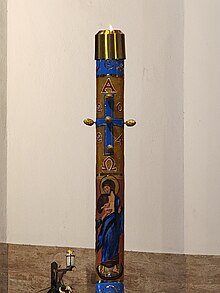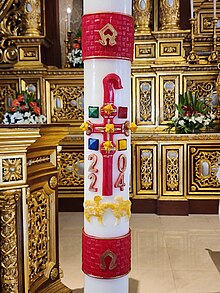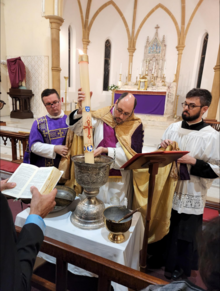|
Paschal candle A Paschal candle is a large candle used in liturgies in Western Christianity (viz., the Roman Catholic Church, the Lutheran Churches, the Anglican Communion, and the Methodist Churches, among others). A new Paschal candle is blessed and lit every year at Easter. It is used throughout the Eastertide and then throughout the year on occasions such as baptisms, funerals and some other special occasions such as the ordination of priests, taking vows or the Consecration of virgins, when the fire from the Paschal candle is carried with a wick to light another liturgical candle, as for example the baptismal candle. The equivalent of the Paschal candle in the Eastern Orthodox Church is the Paschal trikirion, which differs in both style and usage. EtymologyThe term Paschal comes from the Latin word Pascha, which came from the Hebrew word Pesach (/ˈpɛsɑːx, ˈpeɪ-/; פֶּסַח), meaning Passover, and relates to the Paschal mystery of salvation. It is sometimes referred to as the "Easter candle" or the "Christ candle". Description For congregations that use a Paschal candle, it is the largest candle in the worship space. In most cases, the candle will display several common symbols:
In the (medieval) Church, Paschal candles often reached a stupendous size. The Paschal candle of Salisbury Cathedral was said to have been 36 feet (11 metres) tall. At present time, in the United States and Southern Europe (e.g., Italy and France) the candle is approximately 4 inches (10 centimetres) in diameter and 36 to 48 inches (91 to 122 centimetres) tall; in Northern Europe the candle tends to be shorter in height (19 to 24 inches/48 to 61 centimetres) and wider in diameter (3 to 5 inches/7.6 to 12.7 centimetres). The Paschal candle of Manila Cathedral usually reaches 4 or 4.5 inches (10 or 11 centimetres) and stands at 50 inches (130 centimetres) tall. The Paschal candle, like all liturgical candles, must be made at least from the most part of beeswax (ex cera apum saltem in maxima parte).[1] The Church Fathers saw the bee as a symbol of the Virgin Mary.[2] The beeswax symbolized the pure flesh of Christ, received from his mother.[3] UsageEaster VigilFor churches that celebrate the Easter Vigil on the night of Holy Saturday, the ceremonial preparation, dedication and lighting of the Paschal candle is one of the most solemn moments of the service. The Easter Vigil liturgies of the Roman Catholic, Lutheran, Anglican, Methodist and Presbyterian Churches are nearly identical.[4] On Maundy Thursday of the same week the entire church is darkened by extinguishing all candles and lamps. This and the empty tabernacle symbolise the darkness of a world without Christ. At the opening of the Easter Vigil a fire is lit and blessed. The minister will cuts a cross in the wax with a stylus and trace the symbols on the Paschal candle, saying words similar to: "Christ, yesterday and today, the Beginning and the End, the Alpha and the Omega. All time belongs to him and all the ages; to him be glory and power through every age for ever. Amen." He then inserts five grains of incense (reminiscent of the nails used to fasten Christ on the Cross) on the five points of the cross, saying: "By his holy and glorious wounds, may Christ our Lord guard us and keep us. Amen." The Paschal candle is the first candle to be lit with a flame from this sacred fire, representing the light of Christ coming into the world. This represents the risen Christ, as a symbol of light (life) dispelling darkness (death). Before it is lit, the minister says words similar to: "May the light of Christ, rising in glory, dispel the darkness of our hearts and minds."  Typically, the worshiping assembly then processes into the church led by the Paschal candle. The candle is raised three times during the procession, accompanied by the chant "The light of Christ" to which the assembly responds "Thanks be to God". In some communities, it is common for nearby churches of different Christian denominations (e.g. Catholic, Lutheran, Anglican, Methodist and Presbyterian) to make the new Easter Fire together and then after this, each congregation processes back to their own church with their own Paschal Candle for their Easter Vigil celebration; this is considered to be a fostering of ecumenism. Following the procession the Exultet is chanted, traditionally by a deacon, but it may be chanted by the priest or – most parts of it – by a cantor. The Exultet concludes with the offering of the candle: From the Roman Missal:
 After the Litany of the Saints, the Paschal candle is lowered three times into the Easter water to be blessed while the priest sings a prayer of blessing with the request for the descent of the Holy Spirit. In some Eastern traditions, wax is dripped into the water for an even richer symbolism. Other times of the yearThe candle remains in the sanctuary close to the altar and is lit at least in all the more solemn worship services until Pentecost (or in some traditions until Ascension Day when it is extinguished just after the Gospel).[5] In this context the Paschal candle symbolises the presence of the glorified risen Christ. After Eastertide, the candle should be kept in the baptistry, so that in the celebrations of baptisms the candles of the baptized may be lit from the candle.[6] The Paschal candle is lit during baptisms to signify the Holy Spirit and fire that John the Baptist promised to those who were baptised in Christ.[7] Before 1955, the option existed of blessing the baptismal font on the Vigil of Pentecost, and this was the only time the Paschal candle would be lit at services after Ascension. In the Ordinary form of the Roman Rite, the Paschal candle is lit and should be placed near the coffin during the Mass of the repose of the soul or the Requiem. This is to indicate that the death of a Christian is his own passover.[8] Eastern usageIn the Eastern Orthodox and Byzantine Catholic churches, there is no direct correspondence to the Western Paschal candle. However, throughout Bright Week, the priest carries a cross and paschal trikirion at all of the services, especially when censing, during the Little Entrance or when giving the Paschal greeting. The trikirion consists of three lit candles in a candlestick, which the priest carries in his left hand. In the Slavic tradition, the three candles may be white or different colors: green, red, blue. The deacon also carries a special Paschal candle which is a single large candle whenever he leads an ektenia (litany) or censes. References
External linksWikimedia Commons has media related to Paschal candles.
|